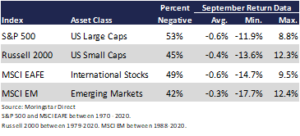September is historically the worst month for investing. Media outlets are happy to point this out. In an effort for brevity, media and investing technicians look to the S&P 500’s September average return for validation. Interestingly, a single data point doesn’t tell the whole story nor offer the proper context.
point this out. In an effort for brevity, media and investing technicians look to the S&P 500’s September average return for validation. Interestingly, a single data point doesn’t tell the whole story nor offer the proper context.
When reviewing market statistics, its preferred to analyze the whole dataset to grasp a full understanding. The accompanying table offers a little more information than most media outlets provide. The first item of note is the representation of different indices and market segments. Secondarily, the information offers a better picture of September’s historical data.
Clearly, September’s average return is negative across all classes. Yet, the returns tend to be skewed to the negative. Hence, when a September decline occurs, it tends to decline more than positive months deliver. This negatively skews the average and interestingly, the S&P 500 has had more negative months than positive months. But there is a low probability a negative S&P 500 return will result. Other asset classes show the opposite with more Septembers delivering positive returns even though the average return is negative.
There is the question of, “when negative September’s happen, why is do they tend to experience high negative returns?” Could it be the presidential cycle, changing weather or a full moon? Other seasonal effects, such as the Santa Claus rally, can be explained, however high negative Septembers continue to plague academics. Some have noted negative global events tend to occur in September (i.e., 9/11, ’08 Credit Crisis begins, Iran/Iraq war began, etc.) while others have suggested the return from summer vacations cause investors to sharpen their pencil with the upcoming October earnings season.
Ironically, this year’s annual media reminders included a prognostication that this September (2021) will be positive1,2,3. The main reasoning was the strong stock market momentum through August. However, September 2021 evolved with a return of volatility and a negative return, as of this typing on September 30th. The moral of the story is the stock market is far more complex than a single data point and directional momentum. Trying to boil investing down to a couple items tends to be a fool’s errand. Be wary of such simplicities or commercials suggesting investing is as easy as looking at a chart, placing a trade and going for a walk on the beach.
In the end, there is no reason to change your long-term strategy because of the quirk of the calendar. Short-term returns tend to have unpredictable randomness, yet longer-term returns tend to revert to the mean.
3. https://www.barrons.com/articles/stock-market-september-history-51630442637?tesla=y
CRN-3850883-100421


Recent Comments